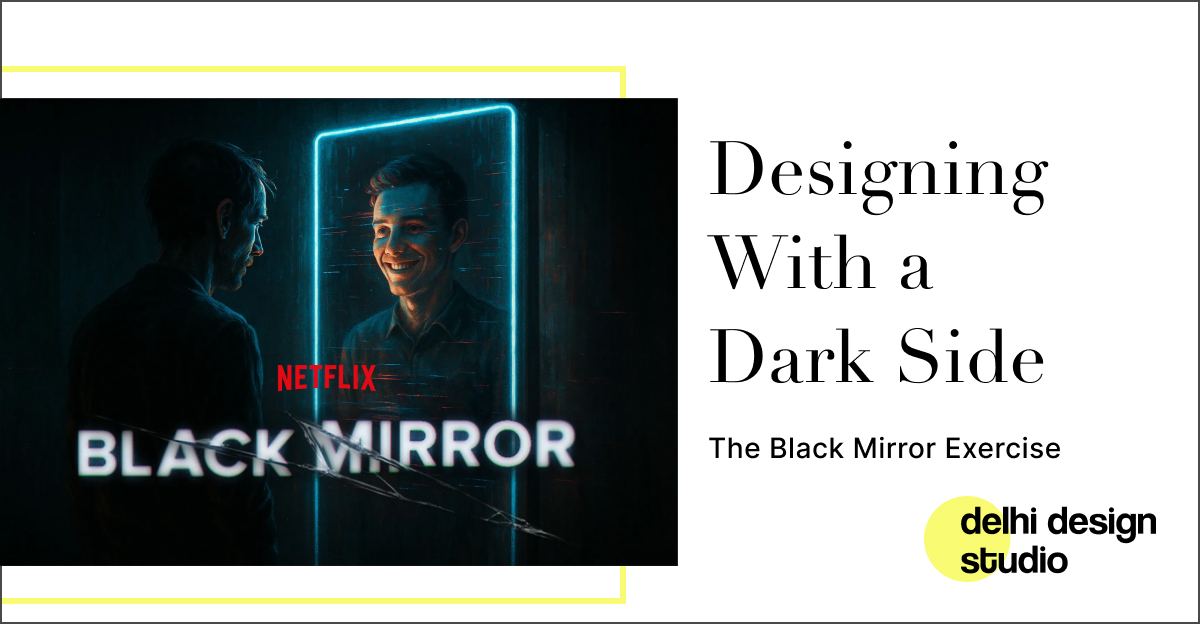
Designing Better by Imagining the Worst
Why our design team writes Black Mirror episodes to sharpen our sense of ethics
Why Black Mirror?
The Netflix series Black Mirror thrives on taking technology that feels familiar—even ordinary—and twisting it into something unsettling. It’s a masterclass in exposing the unintended consequences of good intentions.
As product designers and UX strategists at Delhi Design Studio, we need that same skill: the ability to look past what we hope will happen with our digital products and instead imagine what we really don’t want to happen. Ethical design thinking is not just good practice; it’s a business necessity in today’s digital economy.
How It Works
We structured the design ethics workshop into four parts (about an hour total).
Step 1 — Intro (5 min)
If folks hadn’t seen Black Mirror, we shared a quick synopsis and favorite clips or trailers to set the mood.
Step 2 — Brainstorm (15 min)
Using ethical design prompts (like “How might this exploit someone’s financial insecurity?” or “What if this caused severe anxiety or depression?”), each designer mapped out worst-case scenarios tied to real technology we’re building. Everyone wrote solo before sharing, ensuring quieter voices were heard.
Step 3 — Create Your Episode (20 min)
Teams filled out a Netflix-style template. Each episode included:
Step 4 — Discuss (20 min)
Everyone presented their “episode,” then we rated each on two scales:
The group discussion uncovered blind spots, challenged assumptions, and sparked insights about ethical risks we might otherwise miss.
Example Episode: Reflections
One of our favorite creations:
“People begin using a smart mirror that promises to improve their self-image through subtle AR overlays. Over time, the mirror starts replacing their real memories with idealized versions, until they can no longer tell what’s authentic.”
Seeing the mocked-up episode card, complete with poster art, made the ethical debate tangible. Suddenly, it wasn’t an abstract risk—it felt like something that could launch tomorrow.
Why This Works
Why It Matters
None of us intend to design harmful experiences. But history shows that harm doesn’t require bad intent—just a lack of imagination.
Neither team meant harm. Yet the consequences were deeply painful.
Black Mirror Exercises won’t solve everything, but they give design teams a way to slow down, see differently, and catch risks before they ship.
Prompts for Ethical Brainstorming
Here’s the full set of design ethics prompts we used, adapted from Joshua Mauldin’s Cover Story exercise:
Physical Harm
Emotional Harm
Societal Harm
Additional Lenses
The Delhi Design Studio Difference
By imagining our products as potential Black Mirror episodes, we sharpen our ethical instincts and gain a shared design language. It’s not about predicting dystopias—it’s about protecting the people who will use our products every day.
At Delhi Design Studio, we believe responsible UX design and ethical innovation go hand in hand with business success.
👉 We’re currently offering complimentary design consultancy to help businesses kickstart or refine their product journey—with clarity, creativity, and confidence.